
Davie County is a county located in the U.S. state of North Carolina. As of the 2020 census, the population was 42,712. Its county seat is Mocksville.

Mocksville is a town in Davie County, North Carolina, United States. The population was 5,900 at the 2020 census. I-40 leads west to Statesville and Hickory, and east to Winston-Salem and Greensboro. Route 64 heads east to Lexington, and west towards Statesville and Taylorsville. It is the county seat of Davie County.
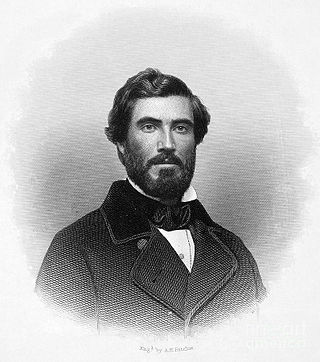
Hinton Rowan Helper, from North Carolina, was a writer, abolitionist, and white supremacist. In 1857, he published a book that he dedicated to the "non-slaveholding whites" of the South. Titled The Impending Crisis of the South: How to Meet It and written partly in North Carolina but published when the author was in the Northern United States, it argued that slavery hurt the economic prospects of non-slaveholders and was an impediment to the growth of the entire region of the South. Anger over his book due to the belief he was acting as an agent of the North attempting to split Southerners along class lines led to Southern denunciations of "Helperism."
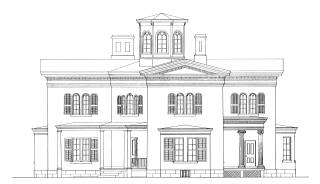
Cooleemee, also known as the Cooleemee Plantation House, is a house located between Mocksville and Lexington, North Carolina, at the terminus of SR 1812 on the Yadkin River in Davie County, North Carolina. It is a U.S. National Historic Landmark, designated in 1978 for its architecture.
Advance is an unincorporated community and census-designated place (CDP) in Davie County, North Carolina, United States. It is seventy-five miles northeast of Charlotte. As of the 2010 census it had a population of 1,138. It is located along North Carolina Highway 801 just south of Bermuda Run. Advance is part of the Piedmont Triad region of North Carolina.
The Impending Crisis of the South: How to Meet It is an 1857 book by Hinton Rowan Helper, who declares himself a proud Southerner. It was written mostly in Baltimore, but it would have been illegal to publish it there, as he pointed out. It was a strong attack on slavery as inefficient and a barrier to the economic advancement of whites. The book was widely distributed by Horace Greeley and other antislavery leaders, and infuriated Southerners. According to historian George M. Fredrickson, "it would not be difficult to make a case for The Impending Crisis as the most important single book, in terms of its political impact, that has ever been published in the United States." In the North it became "the book against slavery." A book reviewer wrote, "Next to Uncle Tom's Cabin (1852), Hinton Helper's critique of slavery and the Southern class system, The Impending Crisis of the South (1857), was arguably the most important antislavery book of the 1850s."
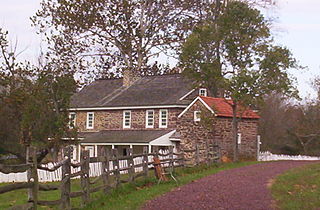
The Daniel Boone Homestead, the birthplace of American frontiersman Daniel Boone, is a museum and historic house that is administered by the Friends of the Daniel Boone Homestead near Birdsboro in Berks County, Pennsylvania. It is located on nearly 600 acres (2.4 km2) and is the largest site owned by the Pennsylvania Historical and Museum Commission. The staff at Daniel Boone Homestead interpret the lives of the three main families that lived at the Homestead: the Boones, the Maugridges and the DeTurks. The park is just off U.S. Route 422 north of Birdsboro in Exeter Township.

James Graham Ramsay was a North Carolina physician and politician who served in the North Carolina Senate and Confederate States Congress during the American Civil War.

Davie County Courthouse is a historic courthouse located at Mocksville, Davie County, North Carolina. It was built in 1909, and is a two-story reinforced concrete and tan brick structure in the Classical Revival style. It features a tetrastyle Corinthian order in antis portico which shelters the center front entrance, with an ornate square clock cupola. The building was restored and renovated following a fire in 1916. The interior was renovated in 1971.

Davie County Jail is a historic county jail located at Mocksville, Davie County, North Carolina. It was built in 1839, and is a two-story, three bay, brick building with a gable roof. It was used as a jail until 1909, then renovated for residential use.
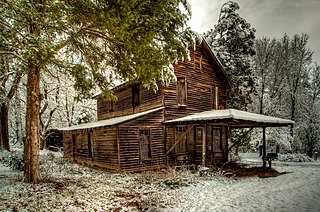
Cana Store and Post Office is a historic general store and post office building located near Mocksville, Davie County, North Carolina. It was built about 1875, and is a two-story, three-bay, frame building with a gable roof. The front facade features a broad hip-roofed frame canopy added in the 1930s that serves as a porte-cochere. Also on the property is a contributing one-story woodshed built in the 1930s. The building housed a post office until 1954 and a general store until 1965.
McGuire-Setzer House is a historic home located near Mocksville, Davie County, North Carolina. The original section of the double-pen log building was built about 1825, with a frame section added about 1835. The dwelling is sheathed in weatherboard and is in a vernacular Federal style. It features gable end brick chimneys and rests on a stone foundation. Also on the property is a contributing kitchen building.
George E. Barnhardt House is a historic house located near Mocksville, Davie County, North Carolina. It is locally significant as a rare surviving example of a post-bellum brick farmhouse in Davie County.
Foard-Tatum House is a historic plantation house located near Cooleemee, Davie County, North Carolina. It was built about 1845, and is a two-story, three bay, timber frame dwelling in a transitional Federal /Greek Revival style. The interior is in the style of Asher Benjamin and a rear ell was added in the 1860s or 1870s. Also on the property are the contributing log smokehouse and corn crib.

North Main Street Historic District is a national historic district located at Mocksville, Davie County, North Carolina. The district encompasses 115 contributing buildings and 2 contributing sites in a linear residential section of Mocksville. It was developed between the 1840s and World War II and includes notable examples of Greek Revival, Italianate, Gothic Revival, Queen Anne, Classical Revival, Shingle Style, American Craftsman, Tudor Revival, and Colonial Revival style residential architecture. Also in the district are the First Methodist Church (1896), the Mocksville Graded School (1911), and the Masonic Picnic Grounds, established in 1883.
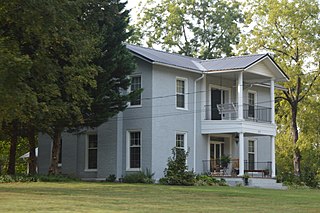
Salisbury Street Historic District is a national historic district located at Mocksville, Davie County, North Carolina. The district encompasses 40 contributing buildings in a predominantly residential section of Mocksville. It was developed between the 1820s and World War II and includes notable examples of Greek Revival, Italianate, Queen Anne, and American Craftsman style residential architecture. The dwellings are predominantly one- and two-story log and frame houses. Also in the district is the (former) Mocksville Academy.

Downtown Mocksville Historic District is a national historic district located at Mocksville, Davie County, North Carolina. The district encompasses 21 contributing buildings and 1 contributing object in the central business district of Mocksville. It primarily includes residential and commercial buildings with notable examples of Classical Revival and Beaux-Arts style architecture. The district includes the previously listed Davie County Courthouse. Other notable buildings include the Davie County Jail (1916), (former) C. C. Sanford Sons Store (1937), (former) J. T. Baity/Anderson Store, (former) Meroney Hardware Company Building (1922-1924), Sanford Brothers Building (1927), (former) Southern Bank &. Trust Company Building (1923), (former) Princess Theatre, J. T. Angell Building (1910), Horn Service Station, (former) Kurfees and Ward Pure Oil Station, (former) Meroney Filling Station, and Johnstone Office Building (1939).
Boxwood Estate is a historic hunting retreat and national historic district located near Mocksville, Davie County, North Carolina. The district encompasses 8 contributing buildings, 1 contributing site, and 4 contributing structures on a rural estate including a manor house. It was developed between 1911 and 1931 by William Rabb Craig (1870-1931), a wealthy cotton and sugar broker. The manor house was built between 1933 and 1934, and is a two-story, "H"-plan, brick Colonial Revival dwelling designed by the architectural firm Delano & Aldrich. Other notable resources include the grounds of Boxwood Lodge, greenhouse, log cabin, great barn (1910s), feed / grain house, and entrance piers (1934).

The Josephus Hall House, also known as the McNeely–Strachan House and Salisbury Academy, is a historic home located at Salisbury, Rowan County, North Carolina, United States. It was built about 1820, as a two-story, frame dwelling. It was remodeled in the 1850s to add its distinctive two-tier flat roofed front porch. The porch features a five bay ornamental cast iron arcade in a grapevine pattern. The roof was modified to the hipped roof form and exterior chimneys rebuilt in 1911. The interior has Federal, Greek Revival, and Late Victorian-style design elements. The building housed the Salisbury Academy girls' school from about 1820 to 1825.
Barber Farm, also known as Luckland, is a historic farm complex and national historic district located near Cleveland, Rowan County, North Carolina. The Jacob Barber House was built about 1855, and is a two-story, single-pile, three-bay vernacular Greek Revival style frame dwelling. It has a one-story rear ell and a one-story shed roofed rear porch. Its builder James Graham also built the Robert Knox House and the Hall Family House. Other contributing resources are the cow barn, smokehouse, granary, double crib log barn, well house, log corn crib / barn, carriage house, school, Edward W. Barber House (1870s), Edward W. Barber Well House (1870s), North Carolina Midland Railroad Right-of-Way, and the agricultural landscape.















